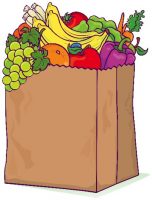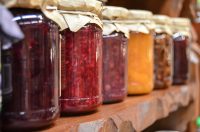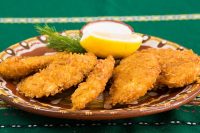by admin | March 2, 2020 10:05 am | By Doc Mueller, Cooking ideas, Environment, Main, Today's Thought
 This week, New York rolled out its’ ban on plastic bags. We all find much joy in not using plastic bags anymore, but is paper any better? Most of us want to band paper bags too and make everyone use reuse bags. (If we had to buy them at the counter to get our food home I’ll bet we would stop forgetting, I know I would☹
This week, New York rolled out its’ ban on plastic bags. We all find much joy in not using plastic bags anymore, but is paper any better? Most of us want to band paper bags too and make everyone use reuse bags. (If we had to buy them at the counter to get our food home I’ll bet we would stop forgetting, I know I would☹
I say: let’s ban paper bags too. Research by the UK Environment Agency has found that paper bag production requires more raw materials and energy, and produces more waste than plastic bag production.
14 billion trees are cut down annually for paper packaging; plastic ones are by-products of oil refining. It takes four times more electricity to  produce a paper than a plastic carrier. Besides, paper bag production emits 70% more air and 50% more water pollutants than its synthetic counterpart.
produce a paper than a plastic carrier. Besides, paper bag production emits 70% more air and 50% more water pollutants than its synthetic counterpart.
A paper bag has to be used at least three times to decrease its impact on the environment to match that of a plastic bag used just once.
New York joined the long line of jurisdictions that have banned plastic bags. Now there are about 66 countries and counting, Bangladesh was the first. The terrifying pictures we have all sen of plugged rivers or dead animals (from ingesting them) have made a mark on us all.
Globally, we produce around 300 million tons of plastic waste per year, which the UN has helpfully equated to the weight of the entire human population.
 Only a small part of this is recycled or incinerated. Almost 80% is merely piling up around us, as litter in our streets, in garbage dumps, and our waters. Depending on the type of product, plastic takes up to 600 years to decompose, all the while contaminating the water we drink and the food we eat. The UN estimates that by 2050, we could have more plastic than fish in our oceans and seas.
Only a small part of this is recycled or incinerated. Almost 80% is merely piling up around us, as litter in our streets, in garbage dumps, and our waters. Depending on the type of product, plastic takes up to 600 years to decompose, all the while contaminating the water we drink and the food we eat. The UN estimates that by 2050, we could have more plastic than fish in our oceans and seas.
Not all is lost, the reusable tote: Many people already have the habit of keeping them handy in our cars, handbags or backpacks and offices for that surprise trip to the grocery. The Environment Agency study estimated that reusable synthetic bags should be used up to 30 times to match the environmental impact of a plastic grocery bag used once, and canvas sacks at least 330 times. The idea is to go as natural as possible and to use them for years. Not only that, you can have them custom made for advertising your website, your business, your grandchildren, just about anything.
by admin | December 30, 2019 8:53 am | Cooking ideas, Diet Tips ( I lost 160 LBS), Health, Main, Success, Well Being
This year has been a bit of a challenge. Starting something new and sticking with it is not always the easiest thing. I have not promoted the web site this year because like all of us I wanted a little content here before I went out Bragging to the world. :-). This is the last Post for 2019 (Happy New Year) next year will be a new challenge with new ideas. Stick with me because a lot of free ebooks and information are coming your way in the next year of my plan.
 9 Healthy Foods That Lift Your Mood
9 Healthy Foods That Lift Your Mood
When you’re feeling down, it can be tempting to turn to food to lift your spirits. However, the sugary, high calorie treats that many people resort to having negative consequences of their own.
Thus, you may wonder whether any healthy foods can improve your mood.
Recently, research on the relationship between nutrition and mental health has been emerging. Yet, it’s important to note that mood can be influenced by many factors, such as stress, environment, poor sleep, genetics, mood disorders, and nutritional deficiencies, Therefore, it’s difficult to accurately determine whether food can raise your spirits.
Nonetheless, certain foods have been shown to improve overall brain health and certain types of mood disorders.
Here are 9 healthy foods that may boost your mood.
Share on Pinterest
- Fatty fish
Omega-3 fatty acids are a group of essential fats that you must obtain through your diet because your body can’t produce them on its own.
Fatty fish like salmon and albacore tuna are rich in two types of omega-3s — docosahexaenoic acid (DHA) and eicosapentaenoic acid (EPA) — that are linked to lower levels of depression Omega-3s contribute to the fluidity of your brain’s cell membrane and appear to play key roles in brain development and cell signaling
While research is mixed, one review of clinical trials showed that in some studies, consuming omega-3’s in the form of fish oil lower depression scores.
Although there’s no standard dose, most experts agree that most adults should get at least 250–500 mg of combined EPA and DHA.
Given that a 3.5-ounce (100-gram) serving of salmon provides 2,260 mg of EPA and DHA, eating this fish a few times per week is a great way to get these fats into your diet.
From these facts, I have determined that fatty fish such as salmon which are rich in omega-e fatty acids, may lower your risk of depression.
- Dark chocolate
Chocolate is rich in many mood-boosting compounds. That’s the best news I’ve had in a long time about food 😉
It’s likely the sugar may be what improves mood since it’s a quick source of fuel for your brain.
Furthermore, it may release a cascade of feel-good compounds, such as caffeine, theobromine, and N-acylethanolamine — a substance chemically similar to cannabinoids that have been linked to improved mood.
However, some experts debate whether chocolate contains enough of these compounds to trigger a psychological response. I choose to absolutely believe this because “I” am a chocolate expert in my own mind.
Nerveless, I want to mention that chocolate is high in health-promoting flavonoids, which have been shown to increase blood flow to your brain, reduce inflammation, and boost brain health all of which may support mood regulation. Chocolate also has a high hedonic rating, meaning that its pleasurable taste, texture, and smell may also promote a good mood.
Because milk chocolate contains added ingredients like sugar and fat, it’s best to opt for the “dark” chocolate which is higher in flavonoids and lower in added sugar. You should still stick to 1–2 small squares (of 70% or more cocoa solids) at a time since it’s a high-calorie food.
Dark chocolate is rich in compounds that may increase feel-good chemicals in your brain. (Ok I vote for this; do we get to vote?)
- Fermented foods
Fermented foods which include kimchi, yogurt, kefir, kombucha, and sauerkraut, may improve gut health and mood. OK, I am going to be honest and up-front about this “I HATE FERMENTED FOODS” I hope you love them. It’s just a thing I have but to me, nothing is as bad as yogurt. I wish I liked it! I see all those people with light easy snacks and getting over a bad stomach thing with their yogurt but it just makes me want to regurgitate.
The fermentation process allows live bacteria to thrive in foods that are then able to convert sugars into alcohol and acids.
During this process, probiotics are created. These live microorganisms support the growth of healthy bacteria in your gut and may increase serotonin levels.
It’s important to note that not all fermented foods are significant sources of probiotics, such as in the case of beer, some breads, and wine, due to cooking and filtering.
Serotonin is a neurotransmitter that affects many facets of human behavior, such as mood, stress response, appetite, and sexual drive. Up to 90% of your body’s serotonin is produced by your gut microbiome or the collection of healthy bacteria in your gut.
In addition, the gut microbiome plays a role in brain health. Research is beginning to show a connection between healthy gut bacteria and lower rates of depression.
Since up to 90% of your body’s serotonin is produced in your gut, a healthy gut may correspond to a good mood. Fermented foods like kimchi, yogurt, kefir, kombucha, and sauerkraut are rich in probiotics that support gut health.
- Bananas
Bananas may help turn a frown upside down.
They’re high in vitamin B6, which helps synthesize feel-good neurotransmitters like dopamine and serotonin.
Furthermore, one large banana (136 grams) provides 16 grams of sugar and 3.5 grams of fiber.
When paired with fiber, sugar is released slowly into your bloodstream, allowing for stable blood sugar levels and better mood control. Blood sugar levels that are too low may lead to irritability and mood swings.
Finally, this ubiquitous tropical fruit, especially when still showing green on the peel, is an excellent source of prebiotics, a type of fiber that helps feed healthy bacteria in your gut. (This is like that yucky orange stuff lot of people drink in the mornings some are pre and some are probiotics. A robust gut microbiome is associated with lower rates of mood disorders.
Bananas are a great source of natural sugar, vitamin B^, a prebiotic fiber, which work together to keep your blood sugar levels and mood stable. What nature won’t do to make us eat right. (Or is that di do?)
- Oats
Oats are a whole grain that can keep you in good spirits all morning. You can enjoy them in many forms, such as overnight oats, oatmeal, muesli, and granola.
They’re an excellent source of fiber, providing 8 grams in a single raw cup (81 grams).
Fiber helps slow your digestion of carbs, allowing for a gradual release of sugar into the bloodstream to keep your energy levels stable.
In one study, those who ate 1.5–6 grams of fiber at breakfast reported better mood and energy levels. This was attributed to more stable blood sugar levels, which is important for controlling mood swings and irritability.
Although other sources of whole grains can have this effect, oats may be especially advantageous, as they’re also a great source of iron, with 1 raw cup (81 grams) boasting 19% of your daily needs.
Iron deficiency anemia, one of the most common Nutrient deficiencies and is associated with low iron intake. Its symptoms include fatigue, sluggishness, and mood disorders.
Some research suggests that people experience improvements in these symptoms after eating iron-rich foods or supplementing with iron, but more research is needed.
- Berries
Curiously, eating more fruits and vegetables is linked to lower rates of depression.
Although the mechanism isn’t clear, a diet rich in antioxidants may help manage inflammation associated with depression and other mood disorders.
Berries pack a wide range of antioxidants and phenolic compounds, which play a key role in combatting oxidative stress — an imbalance of harmful compounds in your body.
They’re particularly high in anthocyanins, a pigment that gives certain berries their purple-blue-color. One study associated a diet rich in anthocyanins with a 39% lower risk of depression symptoms.
If you can’t find them fresh, try buying frozen berries — which are frozen at their peak ripeness to retain the maximum amount of antioxidants.
- Nuts and seeds
Nuts and seeds are high in plant-based proteins, healthy fats, and fiber.
Additionally, they provide tryptophan, an amino acid responsible for producing mood-boosting serotonin. Almonds, cashews, peanuts, and walnuts, as well as pumpkin, sesame, and sunflower seeds, are excellent sources.
Moreover, nuts and seeds are a large component of both the MIND and Mediterranean diets, which may support a healthy brain. Each of these diets promotes fresh, whole foods and limits your intake of processed items.
What’s more, a 10-year study in 15,980 people linked moderate nut intake to a 23% lower risk of depression (FYI, I LOVE nuts, both the people and the food kind).
Finally, certain nuts and seeds, such as Brazil nuts, almonds, and pine nuts, are good sources of zinc and selenium. Deficiency in these minerals, which are important for brain function, is associated with higher rates of depression — although more research is needed.
- Coffee
Coffee is the world’s most popular drink, and it may make the world a bit happier, too.
The caffeine in coffee (tea) prevents a naturally occurring compound called adenosine from attaching to brain receptors that promote tiredness, therefore increasing alertness and attention.
Moreover, it increases the release of mood-boosting neurotransmitters, such as dopamine and norepinephrine.
A study in 72 people found that both caffeinated and decaffeinated coffee and tea significantly improved mood compared with a placebo beverage, suggesting that coffee contains other compounds that influence mood.
Researchers attributed this boost in attitude to various phenolic compounds, such as chlorogenic acid. Still, more research is needed.
Everyone here gets tired of me saying “ill just make some teas, tea fixes everything. Looks Like I was correct 😉
- Beans and lentils
In addition to being high in fiber and plant-based protein, beans, and lentils, are full of feel-good nutrients.
They’re an excellent source of B vitamins, which help improve mood by increasing levels of neurotransmitters like serotonin, dopamine, norepinephrine, and gamma-aminobutyric acid (GABA), all of which are important for regulating mood.
Furthermore, B—vitamins play a key role in nerve signaling, which allows proper communication between nerve cells. Low levels of these vitamins, especially B12 and folate, have been linked to mood disorders, such as depression.
Finally, they’re a good source of zinc, magnesium, selenium, and non-heme iron, which may likewise elevate your spirits.
The bottom line
When feeling blue, you may crave calorie-rich, high sugar foods like ice cream or cookies to try to lift your spirits.
While this might give you a sugar rush, it’s unlikely to help you in the long term — and may have negative consequences as well.
Instead, you should aim for wholesome foods that have been shown to not only boost your mood but also your overall health. Try out some of the foods above to kick-start your positivity routine.
by admin | November 18, 2019 3:18 pm | Cooking ideas

 Some Advice from My Cooking Days:
Some Advice from My Cooking Days:
Everywhere you look, there is a lot of emphasis on cutting the fat out of our daily diets, but who wants to cut out the fat if it means cutting out the flavor? When it comes to baking, there is a way to cut down on your fat intake without changing the ingredients in your favorite recipes. If you switch to nonstick silicone bakeware, you can cut down on your fat intake with minimal effort. Because the bakeware is nonstick, you never have to use butter, shortening, or grease on your pans or sheets to ensure easy food removal.
The first silicone items made exclusively for baking were small silicone mats that fit nicely on your cookie sheet and allowed you to bake cookies without greasing the cookie sheet or worrying about the bottoms getting burned. These little mats were a huge success and stores were hard pressed to keep them in stock.
As the popularity of these mats grew, manufacturers decide to explore the idea of making more bakeware from silicone. They began making spoons, spatulas, and whisks that could withstand high heats and could be used with nonstick cookware with no fear of ruining the coating. Silicone utensils were the perfect choice for candy making or any other project that required a boiling and sticky liquid to be stirred.
Kitchen supply manufacturers also introduced silicone potholders and oven gloves. Because they can withstand heats up to 500 degrees, they are the perfect insurance that you won’t get burned when you pull a hot dish from your oven. They don’t conduct heat the way that a cloth potholder does and they are much sturdier and easy to keep clean than traditional potholders. Home canners fell in love with silicone baker’s mitts because they could actually reach into a pot of boiling water to remove a hot jar of food once it was done processing. As an added bonus these durable potholders do double duty as lid grippers making opening jars a snap.
Once silicone hit kitchens in the form of baking mats, utensils, and pot holders, kitchen experts began to see the potential of this material in everyday baking. Suddenly almost any type of bakeware that could traditionally be found in stainless steel, aluminum, glass, or stoneware was being offered in brightly colored silicone. Stores began selling muffin tins, bread loaf pans, cake pans, and pie pans. The most popular pieces tend to be the specially designed cake pans that allow you to make cakes shaped like everything from roses to pumpkins. They even have mini cake pans that make individual, fancy shaped cakes.
The popularity of silicone bakeware skyrocketed as cooks began to see the benefits of using this material in their kitchens. Foods pop out of silicone pans with amazing ease. You never need to grease, flour, or even use cooking spray on a silicone pan and that adds up to lots of calories and fat grams saved with each meal. Because silicone is very flexible, it is easy to bend and twist it so that cakes and breads pop out easily. You never have to force baked goods out of the pan, so they retain there shape and you don’t see a lot of split and broken cakes.
Silicone is a bakers dream when it comes to making evenly cooked delicacies. The material distributes heat evenly, so you never end up with a cake that is burned around the edges and still not cooked in the middle. It also cools down quickly ensuring that your foods will not continue cooking and possibly dry out once you remove them from the oven.
Because silicone is nonstick, cleanup is a breeze. A little soap and water and any crumb left on your bakeware disappear. It is nonporous, so it never retains any odors from the foods you cook. Completely versatile it goes from oven to table to freezer and can even be thrown in the dishwasher. Once you are done cleaning it, storage is a snap. With its flexibility, you can twist it, bend it, fold it or mash it up so it can fit in the smallest of drawers or cupboards.
If you haven’t tried silicone bakeware, add a piece or two to your kitchen. You will be surprised at its quality and flexibility.
 This week, New York rolled out its’ ban on plastic bags. We all find much joy in not using plastic bags anymore, but is paper any better? Most of us want to band paper bags too and make everyone use reuse bags. (If we had to buy them at the counter to get our food home I’ll bet we would stop forgetting, I know I would☹
This week, New York rolled out its’ ban on plastic bags. We all find much joy in not using plastic bags anymore, but is paper any better? Most of us want to band paper bags too and make everyone use reuse bags. (If we had to buy them at the counter to get our food home I’ll bet we would stop forgetting, I know I would☹ produce a paper than a plastic carrier. Besides, paper bag production emits 70% more air and 50% more water pollutants than its synthetic counterpart.
produce a paper than a plastic carrier. Besides, paper bag production emits 70% more air and 50% more water pollutants than its synthetic counterpart. Only a small part of this is recycled or incinerated. Almost 80% is merely piling up around us, as litter in our streets, in garbage dumps, and our waters. Depending on the type of product, plastic takes up to 600 years to decompose, all the while contaminating the water we drink and the food we eat. The UN estimates that by 2050, we could have more plastic than fish in our oceans and seas.
Only a small part of this is recycled or incinerated. Almost 80% is merely piling up around us, as litter in our streets, in garbage dumps, and our waters. Depending on the type of product, plastic takes up to 600 years to decompose, all the while contaminating the water we drink and the food we eat. The UN estimates that by 2050, we could have more plastic than fish in our oceans and seas.





Recent Comments